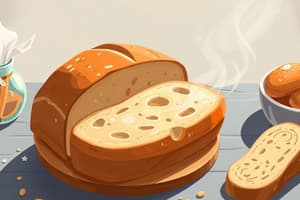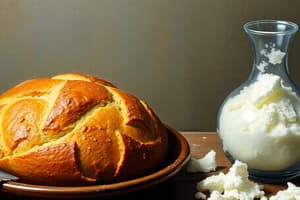Podcast
Questions and Answers
Which solid fat is primarily used for greasing pans and is less flavorful than butter?
Which solid fat is primarily used for greasing pans and is less flavorful than butter?
- Lard (correct)
- Butter
- Margarine
- Shortening
What is the main purpose of eggs in baked products?
What is the main purpose of eggs in baked products?
- To retain moisture and extend shelf life (correct)
- To improve color and make products durable
- To replace fats in the recipe
- To add texture and flavor only
What is the role of baking powder in baking?
What is the role of baking powder in baking?
- To replace flour in recipes
- To help balance leavening with acid (correct)
- To enrich products with protein
- To provide moisture and flavor
Which type of milk is processed to prevent the cream from separating?
Which type of milk is processed to prevent the cream from separating?
What is a common characteristic of powdered milk in baking?
What is a common characteristic of powdered milk in baking?
Which type of fat is generated through hydrogenated animal and vegetable oils?
Which type of fat is generated through hydrogenated animal and vegetable oils?
What disadvantage does adding too many eggs to a baked product create?
What disadvantage does adding too many eggs to a baked product create?
Which is a primary characteristic of liquid fats like oils in baking?
Which is a primary characteristic of liquid fats like oils in baking?
What is the primary role of salt in baking?
What is the primary role of salt in baking?
Which of the following is NOT a characteristic of sour cream?
Which of the following is NOT a characteristic of sour cream?
What type of ingredient is referred to as an emulsion?
What type of ingredient is referred to as an emulsion?
Which ingredient contributes the most to the creamy texture found in yogurt?
Which ingredient contributes the most to the creamy texture found in yogurt?
Which measurement tool is specifically used for measuring liquid ingredients?
Which measurement tool is specifically used for measuring liquid ingredients?
What is the primary purpose of the whipping process in cooking?
What is the primary purpose of the whipping process in cooking?
What is the purpose of a pastry blender in baking?
What is the purpose of a pastry blender in baking?
Which of the following is a defining characteristic of baker's cheese?
Which of the following is a defining characteristic of baker's cheese?
What does the process of caramelizing involve?
What does the process of caramelizing involve?
What type of flouring agent is provided by extracts?
What type of flouring agent is provided by extracts?
At what stage in bread production does the yeast consume sugar and create carbon dioxide?
At what stage in bread production does the yeast consume sugar and create carbon dioxide?
What is the purpose of the punching step in bread production?
What is the purpose of the punching step in bread production?
Which of the following methods is NOT a way to mix dough?
Which of the following methods is NOT a way to mix dough?
What is the main action performed during the 'dredging' process?
What is the main action performed during the 'dredging' process?
What is a key characteristic of the proofing stage in bread making?
What is a key characteristic of the proofing stage in bread making?
What is the total converted weight of 1/3 cup sugar and 3 teaspoons sugar?
What is the total converted weight of 1/3 cup sugar and 3 teaspoons sugar?
What does sifting primarily aim to achieve when preparing dry ingredients?
What does sifting primarily aim to achieve when preparing dry ingredients?
How many grams does 3/4 cup of milk weigh?
How many grams does 3/4 cup of milk weigh?
If a recipe requires 1/2 cup of cocoa powder, how many grams does it require?
If a recipe requires 1/2 cup of cocoa powder, how many grams does it require?
What is the total weight of 1 cup of crushed graham and 1/4 cup of crushed graham?
What is the total weight of 1 cup of crushed graham and 1/4 cup of crushed graham?
How many tablespoons are equivalent to 1/2 cup of cream cheese?
How many tablespoons are equivalent to 1/2 cup of cream cheese?
What are the main ingredients traditionally used to make bread?
What are the main ingredients traditionally used to make bread?
Which type of dough contains the least amount of fat?
Which type of dough contains the least amount of fat?
What is a characteristic of enriched doughs?
What is a characteristic of enriched doughs?
Which of the following is a common measurement used for liquid ingredients?
Which of the following is a common measurement used for liquid ingredients?
Which type of bread is typically more flavorful due to added ingredients?
Which type of bread is typically more flavorful due to added ingredients?
What is the purpose of adding fat to yeasted doughs?
What is the purpose of adding fat to yeasted doughs?
Which measurement is equivalent to 1 liter?
Which measurement is equivalent to 1 liter?
What type of breads generally have a crusty exterior?
What type of breads generally have a crusty exterior?
Flashcards are hidden until you start studying
Study Notes
Types of Fats
- Liquid fats include oils that are less common in baking but enhance certain cakes and breads.
- Common solid fats are lard, butter, and margarine.
- Lard can be derived from pork or vegetables; used primarily for greasing pans and in pie crusts, it lacks the richness of butter.
- Butter contains 80% fat and provides a rich flavor to bakery products.
- Margarine serves as a cheaper butter substitute, made from hydrogenated fats, with a distinct flavor profile.
Role of Eggs
- Eggs add protein, moisture retention, and nutritional value to baked products.
- They can be used whole or separated into yolks and whites, affecting texture and toughness.
- Specific effects of eggs include:
- Moisture retention
- Nutritional enrichment through yolks
- Improved emulsification for better quality
- Enhanced color, especially as a glaze
- Extended shelf life
Chemical Leaveners
- Baking soda (sodium bicarbonate) retains moisture and releases carbon dioxide to leaven products.
- Baking powder is a combination of baking soda, acid, and starch, controlling leavening levels.
- Milk contributes texture, flavor, and nutritional value; it is essential for gluten development and comes in various forms, including:
- Pasteurized
- Raw
- Certified
- Homogenized
- Powdered
Dairy Variants
- Buttermilk is cultured milk with a tangy flavor, while sour cream has added lactic acid for a thick texture.
- Yogurt is another cultured dairy that adds creaminess and flavor.
- Both evaporated and condensed milk are also utilized in baking.
Ingredients Enhancing Flavor
- Salt adds natural flavor and strengthens gluten, balancing yeast growth and prolonging shelf life.
- Vanilla extract, derived from vanilla beans, is a widely used flavoring in baking.
- Alcohol can enhance flavor, while spices and herbs add complexity.
- Fresh, dried, or frozen fruits contribute depth, texture, and visual appeal to baked goods.
- Nuts add crunch and flavor, while various cheeses like baker's cheese and cream cheese provide moisture and richness.
Essential Baking Tools
- Measuring tools include measuring spoons, cups, liquid measuring glasses, and weighing scales for accuracy.
- Cutting, mixing, and blending tools such as dough cutters, pastry blenders, kitchen knives, spatulas, and rolling pins are crucial for preparation and incorporation of ingredients.
Baking Techniques
- Preheating an oven ensures proper temperature for baking.
- Techniques include whisking for aeration, caramelization for sweetness, dredging for coating, sifting for even texture, and scalding milk for recipes.
Bread Production Steps
- The stages include:
- Preparation of ingredients
- Mixing the dough using methods like straight dough, sponge dough, or modified straight dough
- Fermenting to develop flavor and structure
- Punching and shaping the dough
- Proofing before baking
- Cooling and storing the finished bread
Bread Classification
- Yeasted Doughs: Made with yeast and can include fats for enhanced quality.
- Lean Doughs: Contain minimal fat and result in crusty bread, using wheat or bread flour.
- Enriched Doughs: Feature added fats (milk, butter, sugar) for tender texture and flavors.
Measurement and Conversion
- Various measurement systems are employed for both solids and liquids, utilizing grams, ounces, liters, and milliliters.
- Common conversions include:
- 1 teaspoon = 5 grams/milliliters
- 1 tablespoon = 15 grams/milliliters
- 1 cup = 240 grams/milliliters
Example Recipes and Conversions
- A chocolate cupcake recipe yields 12 pieces, with precise measurements converted from cups to grams.
- A cheesecake recipe yields 8 servings, showcasing conversion practices for various ingredients.
Studying That Suits You
Use AI to generate personalized quizzes and flashcards to suit your learning preferences.



